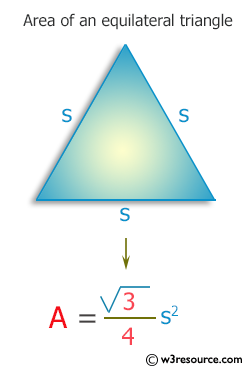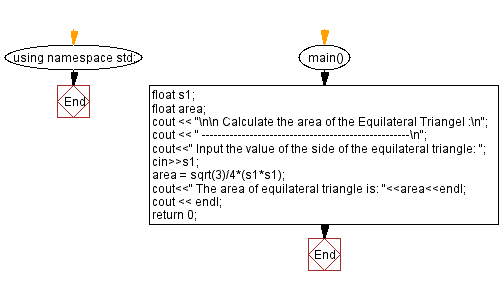C++ Exercises: Calculate area of an equilateral triangle
Equilateral Triangle Area
Write a C++ program to calculate the area of an equilateral triangle.
Visual Presentation:

Sample Solution:
C++ Code :
#include<iostream> // Including input-output stream header file
using namespace std; // Using the standard namespace
#include<math.h> // Including the math library header file for mathematical operations
int main() { // Start of the main function
float s1; // Declaring a variable to store the side length of the equilateral triangle
float area; // Declaring a variable to store the area of the equilateral triangle
cout << "\n\n Calculate the area of the Equilateral Triangle :\n"; // Displaying the purpose of the program
cout << " ----------------------------------------------------\n";
cout << " Input the value of the side of the equilateral triangle: "; // Prompting the user to input the side length
cin >> s1; // Taking input of the side length from the user
area = sqrt(3) / 4 * (s1 * s1); // Calculating the area of the equilateral triangle using the formula
cout << " The area of the equilateral triangle is: " << area << endl; // Displaying the calculated area
cout << endl; // Displaying an empty line for better readability
return 0; // Returning 0 to indicate successful program execution
}
Sample Output:
Calculate the area of the Equilateral Triangle : ---------------------------------------------------- Input the value of the side of the equilateral triangle: 5 The area of equilateral triangle is: 10.8253
Flowchart:

For more Practice: Solve these Related Problems:
- Write a C++ program that calculates the area of an equilateral triangle using both the standard formula and Heron’s formula for verification.
- Write a C++ program to compute the area of an equilateral triangle, then scale the triangle by a factor and recalculate the area.
- Write a C++ program that takes the side of an equilateral triangle as input and outputs the area rounded to four decimal places using fixed-point notation.
- Write a C++ program to calculate the area of an equilateral triangle and compare it with the area of a triangle of the same perimeter.
Go to:
PREV : Third Angle of Triangle.
NEXT : Simple Interest Calculation.
C++ Code Editor:
Have another way to solve this solution? Contribute your code (and comments) through Disqus.
What is the difficulty level of this exercise?
